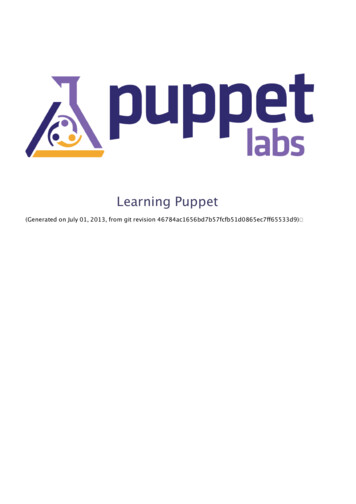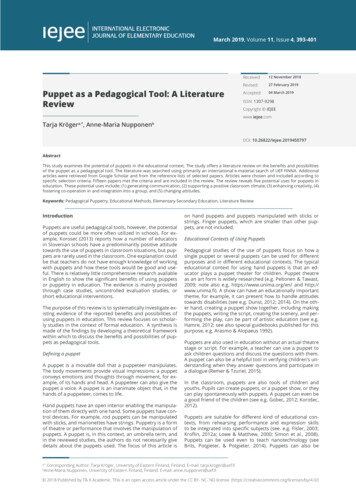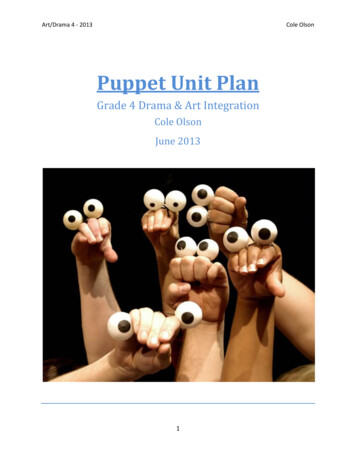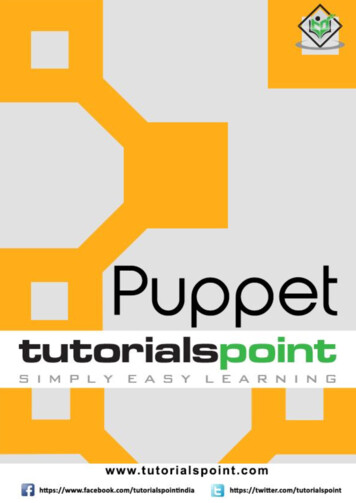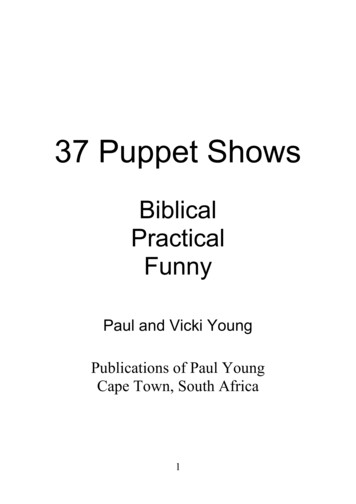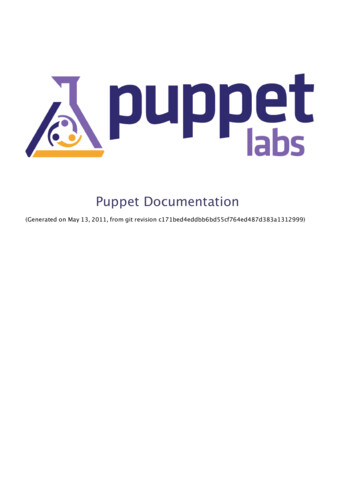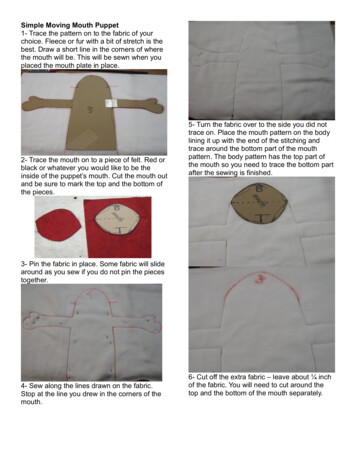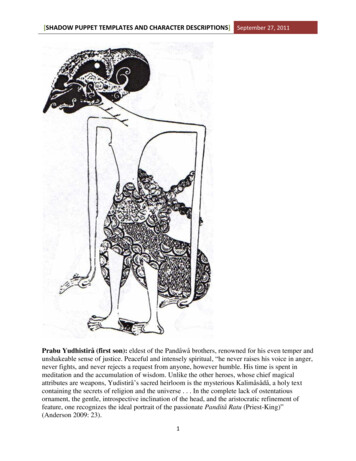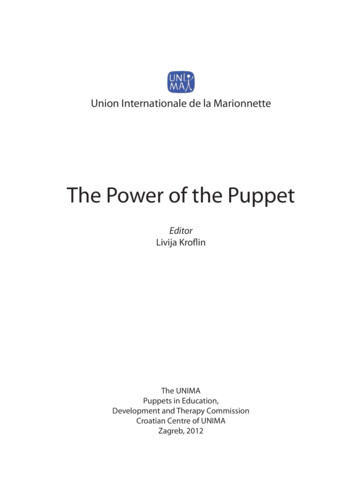
Transcription
Union Internationale de la MarionnetteThe Power of the PuppetEditorLivija KroflinThe UNIMAPuppets in Education,Development and Therapy CommissionCroatian Centre of UNIMAZagreb, 2012final 12 06 2012 .indd 312.6.2012 17:46:38
THE POWER OF THE PUPPETPublishersThe UNIMA Puppets in Education, Development and Therapy CommissionCroatian Centre of UNIMAEditorLivija KroflinEnglish Language EditorMeg AmsdenReviewersIva Gruić, Ph.DProf. Dr. Robi KrofličDr Peter LangLayout, Design & Printed byTeovizija, ZagrebA print run of 400 copies UNIMA 2012All Rights ReservedA CIP catalogue record for this book is available from theNational and University Library in Zagreb under 804855ISBN 978-953-96856-6-7final 12 06 2012 .indd 212.6.2012 17:46:38
CONTENTSPREFACELivija Kroflin . . . . . . . . . . . . . . . . . . . . . . . . . . . . . . . . . . . . . . . . 7Art as a Pathway to the ChildEdi Majaron . . . . . . . . . . . . . . . . . . . . . . . . . . . . . . . . . . . . . . . 11Affective Education through the Art ofAnimation TheatreIda Hamre. . . . . . . . . . . . . . . . . . . . . . . . . . . . . . . . . . . . . . . . . 18Playing with Puppets in Class – Teachingand Learning with PleasureHelena Korošec . . . . . . . . . . . . . . . . . . . . . . . . . . . . . . . . . . . . . 29The Role of the Puppet in LanguageTeachingLivija Kroflin . . . . . . . . . . . . . . . . . . . . . . . . . . . . . . . . . . . . . . . 46Puppetry for DevelopmentCariad Astles . . . . . . . . . . . . . . . . . . . . . . . . . . . . . . . . . . . . . . . 63The Politics of Applied PuppetryMatt Smith . . . . . . . . . . . . . . . . . . . . . . . . . . . . . . . . . . . . . . . . 79Being Carbon NeutralMeg Amsden . . . . . . . . . . . . . . . . . . . . . . . . . . . . . . . . . . . . . . . 86Puppets and the Emotional Developmentof Children – an International OverviewBarbara Scheel . . . . . . . . . . . . . . . . . . . . . . . . . . . . . . . . . . . . . 96Biographies of the Authors . . . . . . . . . . . . . . . . . . . . . . . . . . 107Index of names . . . . . . . . . . . . . . . . . . . . . . . . . . . . . . . . . . . 113Index of terms . . . . . . . . . . . . . . . . . . . . . . . . . . . . . . . . . . . . 116final 12 06 2012 .indd 512.6.2012 17:46:39
PREFACEThe power of the puppet shows itself in diverse fields: not only inthe puppet theatres, not only in rituals and magical spells, but alsoin the broad range of education and therapy. This has also been recognised by the international puppetry organisation – UNIMA – andthe Puppets in Education Commission was founded at the Congressin Budapest in 1996. Its first president was Edi Majaron. Since the Congress in Magdeburg in 2000, the presidency has been headed up byLivija Kroflin. The Commission was expanded at the Congress in Perthand its name was changed to Puppets in Education, Developmentand Therapy. Its current members are: Meg Amsden (Great Britain),Edmond Debouny (Belgium), Ida Hamre (Denmark), Livija Kroflin(Croatia), Edi Majaron (Slovenia) and Barbara Scheel (Germany).The aims of the EDT Commission are:- to stress the importance of the art of puppetry with its unique abilityto communicate;- to encourage creative ways of using puppets from earliest childhood and throughout life;- to encourage researchers to engage with the field of puppetry ineducation, development and therapy, and to share their results;- to encourage the inclusion of puppetry in the training curricula ofteachers, therapists and development workers;- to encourage professional puppeteers to collaborate with educators, therapists, community and development workers and otherprofessionals, to use puppetry in their fields.One of the ways to achieve those objectives is through the publication of books. In 2002, the Puppets in Education Commission publishedThe Puppet – What a Miracle! The book was published in the Englishlanguage, and then the edition in French followed in 2006. Althoughthere is a translation into Spanish, it has not been published as yet.Almost all the members of the EDT Commission took part in theconference “Promoting the Social Emotional Aspects of Education;7final 12 06 2012 .indd 712.6.2012 17:46:39
A Multi-faceted Priority” that was held in Ljubljana, Slovenia, in June2011. The conference was organized by and took place at the University of Ljubljana, Faculty of Education. It was based on the EuropeanAffective Education Network (EAEN), which has an interdisciplinarymembership of scholars, researchers and practitioners interested inthe “affective” dimension of educational process.After having successfully acted as ambassadors for puppetry ineducation and therapy, also promoting the name and ideas of UNIMA,the Commission members decided to prepare a book in which all thepapers presented by the Commission members and correspondingmembers at the Ljubljana Conference would find their place, alongwith those of other members and corresponding members of theCommission, with other experts in the field being invited to send theircontributions.The result is this book, which contains articles presented at the conference in Ljubljana (some in an expanded form) by the members M.Amsden, I Hamre, L. Kroflin, E. Majaron, B. Scheel; corresponding member Helena Korošec, with articles by Cariad Astles and Matt Smith.The book covers all three areas: education, development (writtenby three authors from Great Britain, who use that very appropriateterm applied puppetry) and therapy.Edi Majaron writes about the important part that puppets play invarious aspects of a child’s development. He expresses his belief in themagical power of the puppet in all kinds of communication with children,which enlightens their talents and different forms of their creativity.Ida Hamre’s article “Affective Education through the Art of Animation Theatre” was based on her PhD dissertation “Animation Theatre asan Art and as an Element of Aesthetic Development and Education”and the project aimed to provide fundamental and elementary introductions to animation theatre in schools, at colleges for teachers, andfor educators. In this article she focuses on a “knowledge of confiding”,emotional learning and working together, humour and “utopian imagination”.Helena Korošec stresses the need to make puppets a part of everyday work in education. According to her, symbolic play with puppets8final 12 06 2012 .indd 812.6.2012 17:46:39
complements frontal, one-way communication in the classroom, creates an atmosphere of relaxation, enables an individualistic approach,non-verbal communication and fosters creativity.Livija Kroflin writes about her experience in teaching a second orforeign language – particularly Croatian as a second or foreign language – under the specific conditions of a brief workshop for childrenof various ages, with differing pre-knowledge of the language anddiverse motivations. In these circumstances the puppet has shownits importance in the role of motivator, eliminator of inhibitions andan integrating element for a group of children who barely know eachother.Cariad Astles contributes an article which is an overview of puppetry for development internationally. She explains the terms Theatrefor Development and Puppetry for Development, and examines threeseparate case studies of Puppetry for Development: activities of theCommunity Health Awareness Puppeteers (Kenya), Gary Friedman(South Africa) and Small World Theatre (UK).Matt Smith asks himself two questions: Where do we find the politicsin the practice of applied puppetry? How can puppetry be engaged asa tool in applied theatre practice? His article concerns the ideologicaluses and political purposes of puppetry in education and communitycontexts.Meg Amsden presents an example from practice. In her article subtitled “Teaching Sustainability Through Shadow Puppetry – A PracticalExample of a Project to Encourage 7 –11 Year-olds to Design for TheirFuture” she describes the Being Carbon Neutral project, that she andher colleague Nicky Rowbottom conducted in schools in the BroadsNational Park in 2009. The objective of the project was to encouragechildren to think dynamically and positively about living sustainably ina future dominated by climate change.Barbara Scheel describes her worldwide experience in puppettherapy, and puppetry in schools and institutions for disabled people.She expresses her belief that puppetry is one of the most self-differentiating tools for communication and expression of emotions and is awonderful tool for therapy, education and special needs.9final 12 06 2012 .indd 912.6.2012 17:46:39
Although the authors represented here share similar ideas, thestances the authors express in the individual articles are, of course,their own and not necessarily those of the whole group of contributors and/or of the EDT Commission.We believe that this book will be a welcome contribution to theever-widening understanding of the power of the puppet in variousfields of life.Livija KroflinPresident of the EDT Commission10final 12 06 2012 .indd 1012.6.2012 17:46:39
Edi MajaronART AS A PATHWAY TO THE CHILDArt plays an important part in various aspects of a child’s development. The puppet especially provides the child with a kind of cover ordisguise to hide behind: a timid child finds the courage to speak, to express his/her own emotions and to open his/her secrets to the puppetand through it to the audience. In this manner the puppet helps the childto communicate much more spontaneously, avoiding stressful relationships, especially with adults. The puppet is an authority selected by thechild himself.Contemporary attempts to use narration as a method of rediscovering and stabilising the child’s personality are supported by using puppets.Besides the fact that a child is not able to express all his feelings verbally,puppet heroes help him find words and another point of view or perspective. In addition, children accustomed to using puppets in their everydayconversations have a richer vocabulary. They are able to understand thesemiotic-symbolic value of visual signs and the language of non-verbalcommunication, which is important in identifying their real abilitiesand progress in important areas of development – cognition, sensation,movement and co-ordination, social skills and last but not least, language expression.Through his experience in working with puppets, the author believes inthe magical power of the puppet in all kinds of communication with children, enlightening their talents and different forms of their creativity.Key words: child, art, communication through and by art, symbolicplay, puppetArt is an important part of culture that most distinctly separates ahuman being from all other living creatures. It derives from ancientrituals, presenting human communication with gods as a sign of respect and dependence on their will. Rituals were always expressed11final 12 06 2012 .indd 1112.6.2012 17:46:39
Edi Majaronby stylised visual appearance(by costume, mask ), symbolicmovements and specific sounds.These are the roots of all the arts.Over thousands of years mankindhas accumulated a precious heritage, enriched from generation togeneration with new art-workscontributed by the most brilliantartists. This heritage fills our lives with positive energy, confronts us withourselves and provokes us to be conscious and proud human beings.It is therefore of the utmost importance for every child to get a chanceas soon as possible to be confronted with the many faces of art: everything that surrounds him/her belongs to visual culture; the environment is therefore so important for the child’s development. Music calmschildren or encourages them to move, to dance. Children’s games withtoys are their first interaction with the environment, becoming soon asymbolic play of roles, closely related to their experience and knowledgeabout the world that surrounds them. This world is enormous, so children use puppets (as the smallest art form) – most appropriate to theirsize – to solve their problems in a parabolic way. When they invite theirparents or peers as an audience, theatre is born.What is theatre? Where did it come from? Why?It is a symbolic form of communication and transmission of messages; therefore it’s not as stressful as everyday direct interaction. Deriving from rituals it is stylised on 3 levels (as emphasised before): visually,in movement and insound – that means:very expressive andclear in nonverbalcommunication. This isthe primary reason touse it also in the educational process, sincenonverbal language isunderstandable also tovery young children.12final 12 06 2012 .indd 1212.6.2012 17:46:39
ART AS A PATHWAY TO THE CHILDWhat is the difference between “actor’s theatre” and puppet theatre?An actor’s play expresses personal EGO, while on the otherhand play with a puppet needstransmission of attention/energy from the puppeteer to his“object (puppet)”, resulting inan indirect communication, andavoiding direct personal “eye toeye” stressful contact. Transmission of personality to an objectis something special: the belief in miraculous transformation can becompared to the child’s relationship to his/her toys. In the child’s fantasy, each object has its own life and soul. Objects and toys take over thefunction of an imaginative world in which the child dictates the rules andsearches for possible solutions to his unsolved problems. According toVigotsky, this kind of game improves the child’s development at all stages.Surprisingly, puppetry integrates nearly all disciplines important for thisdevelopment: perception, th the environment,speech, narration. It isdifficult to explain thefact that puppets usually make better contactwith the child than preschool teachers or evenparents. It seems thatit is the already mentioned three-levelled stylisation which helps the child to feel, to acceptand understand a symbolic situation. Through the simplified situationof metaphorically used objects, it is possible to discover the richness ofparabolic games, provoking the child’s imagination and creativity as themost important factors in further development.13final 12 06 2012 .indd 1312.6.2012 17:46:40
Edi MajaronCreating a puppet is anact, supporting a child’s selfesteem.A new challenge startswith moving the new-bornpuppet. But it is not enoughonly to move it! Youngerchildren will discover themiracle of animation spontaneously: by watching theirpuppet, e.g. transferring thefocus of their eyes to theirpuppet, as in their everyday games with toys. The result is fascinating:next to the living puppet, there is no more room for the child’s emphasised ego. And vice-versa: shy children will gather more courage to express themselves through puppets, presenting them like some kind ofshield. The principles of this game, where the child’s concentration onthe object-toy comes back to the child, transforms into a play, wherea message is directed at another player and/or audience (Cultural Mediation, Vigotsky).That is why it is important to establish verbal communication, whichis another great aim in the child’s development: how to use words, formsentences, invent dialogues – posing different puppets in parabolicconflicts, creating paraphrases of known stories using the same characters, or inventing completely new situations. Here we can see the realpower of puppets: visual appearance prompts the invention of a corresponding voice. So the need for narrative expression is supported intensively by other creative actions.A puppet can sing, speak unfamiliar foreign languages, innovate words and expressionsfor new events. In conversationit can provide the opportunityto hear another, it can recitestories and poems in a literaryversion, or retell them from thepoint of view of a person ap14final 12 06 2012 .indd 1412.6.2012 17:46:41
ART AS A PATHWAY TO THE CHILDpearing in the story or poem. The puppet is often curious. It likes to askquestions – usually very provocative ones. It is also prepared to help thechild tidy up his things, jump when he is afraid, creep through a tunnel,go to a doctor or brush his teeth. A puppet can speak a dialect or children’s slang, so children can suggest corrections in common language.It can happen that the child is not able to understand all the words ofa narration, but will accept the meaning through other elements of thepuppet’s non-verbal language. Besides, it is important that the puppetneeds few but essential words. It is not a chatterbox, wasting words invain. And if a sentence isn’t right, it doesn’t matter! That’s the puppetmaking errors, not the child. And a shy child is not fighting for his/herown position but for the position of his/her puppet!A puppet can also personify ideas, mathematical data, days in theweek or letters of the alphabet; all this and much more in the hands of aninventive educator, who is able to live with children in their own wonderland, invented together. Thus the child is supported in his imaginative andreproductive creativity, an active child in an active environment.That means that the use of puppets is not only for very little children but for all ages – depending on their ability and the motivationof the teacher/ educator.15final 12 06 2012 .indd 1512.6.2012 17:46:42
Edi MajaronThe puppet provides both important poles of the child’s needs: a kindof ritual – with daily repetition on one side (i.e. the morning circle.), andsurprise in discovering new possible “languages” on the other.Through these activities the teacher will recognise all the capacitiesand knowledge of eachand every child in thegroup/class without anystress, through playingtheatre (including beingthe audience, not just theperformer), as a result ofsocialisation.The use of puppets (including visual expression and music) can result in a considerable contribution to a more humane and less stressful educational system in the first years of a child’s integration into agroup. Moreover, puppets arouse imagination and creativity. This isone of the simplest and most effective ways to develop and supportthe child’s curiosity about the environment. And when it’s filled withthe arts – children will accept this same method of communication, torespond through the language of the arts. That is the best dowry forchildren in their further development.All photos are taken from the author’s photo archive.16final 12 06 2012 .indd 1612.6.2012 17:46:43
References:Batistič-Zorec, M. (2006) Teorije v razvojni psihologiji, Ljubljana:PeFUL.Bernier, M. & O’Hare, J. (ed. 2002) Puppetry in Education and Therapy, Boston: AuthorHouse.Hamre, I. (2004) Learning trough Animation Theatre, Copenhagen:Danmarks Pædagogiske Universitet.Huff, M. J. (1998) Storytelling with Puppets, Props & Playful Tales,Palo Alto: Monday Morning Books.Korošec, H. (2006) Vključevanje lutk v vzgojno izobraževalno delo,in: Sodobna pedagogika 57/123, Ljubljana.Majaron, E. & Kroflin, L. (ed., 2002) The Puppet – What a Miracle!,Zagreb: UNIMA Puppets in Education Commission.Broggini, W. (1995) La magia del burattino, Bergamo: Junior Edizioni.Hunt, T. & Renfro, N. (1979) Puppetry in Early Childhood Education,Austin: Nancy Renfro Studios.Renfro, N. (1982) Discovering the Super Senses through Puppetmime, Austin: Nancy Renfro Studios.Moyles, R. J. (1996) The Excellence of Play, Buckingham: Open University Press.Sommers, J. (ed.) Drama & Theatre in Education – ContemporaryResearch, Canada: Captus Press.17final 12 06 2012 .indd 1712.6.2012 17:46:43
Ida HamreAFFECTIVE EDUCATION THROUGH THEART OF ANIMATION THEATREThe starting point is the Ph. D. dissertation “Animation Theatre asan Art and as an Element of Aesthetic Development and Education”,Copenhagen 1994 by Ida Hamre.This research suggested that animation theatre has many potentialities for learning, but it was not based on practical-pedagogical surveys.Therefore, another project was launched in 1998. Time schedule: 4 years.This last project aimed to provide fundamental and elementary introductions to animation theatre in schools, at colleges for teachers, andfor educators. It was called “The Learning Potential and Figurative Language of Animation Theatre – a Survey of Basic Aesthetic Learning Processes, Content Areas and Teacher Qualifications”.In this article the author wants to focus on some aspects of the conclusions – such as:- A KNOWLEDGE OF CONFIDINGThe animation process in itself is a knowledge of confiding with astrong appeal to the visual and tactile senses. It demands attention andquietness. This state of mind seems to be a need and, at the same time, itpromotes concentration.- EMOTIONAL LEARNING AND WORKING TOGETHERAccording to art researcher David Best, the artistic experience is characterized as an emotional and cognitive shock. So we are not dealingwith a dichotomy of opposites, but with a complementary relationship.Best uses the term “emotional learning”.The animated figure communicates through a permanent alienationand, in principle, this places performers and spectators on an equal footing, both in terms of the figure and the story. The figure functions as18final 12 06 2012 .indd 1812.6.2012 17:46:43
AFFECTIVE EDUCATION THROUGH THE ART OF ANIMATION THEATREraw material for communication and, as such, becomes an appropriatemedium of dialogical pedagogy.- HUMOURHumour breaks with habitual thinking and paves the way for positive“breaches of pattern”. Humour is related to the joy of life and it touchesupon the basis of all learning.The figures of animation theatre have great power to fascinate. This istrue of all types of figures, regardless of their shapes and sizes.The characteristic features of figurative language in the aesthetics ofanimation theatre and communication contribute to the development ofan aspect of imagination, which the writer will call “the utopian imagination”.Key words: emotional learning through a knowledge of confiding,humour, the art of animation theatreThe starting point for this paper is my Ph. D. dissertation “AnimationTheatre as an Art and as an Element of Aesthetic Development andEducation”. (Animation Theatre is a wider conception of Puppet Theatre). My starting point is also my later practical-pedagogical projectcalled “The Learning Potential and Figurative Language of AnimationTheatre – a Survey of Basic Aesthetic Learning Processes, Content Areasand Teacher Qualifications”.These projects have shown that animation theatre holds great potential in terms of making way for the pupil’s aesthetic, emotional, andethical learning and “Bildung” (German concept for the general cultural and social development of the individual). In the following, I focuson some of the potential for this form of theatre.In my book “Marionet og menneske, animationsteater –billedteater”(“Marionette and Man, Animation Theatre – Visual Theatre), I have summarised the following typical communicative features,allowing myself to be inspired by other researchers, and furthermorereferring to domestic and international performances that I have studiedand experienced.19final 12 06 2012 .indd 1912.6.2012 17:46:43
Ida HamreTypical features in the communication of animation theatre:- Ambiguity and translucency (two-sided appearance).- Metaphor and transitional phenomena.- Permanent alienation.- Synergy.- Abstraction and stylisation.- Special theatre conventions.- Protection of the player’s integrity.- Dialogic work process.- Pantomimic.- Humour and utopia.- Theatre of paradox, live figures, although.- Cross-aesthetic expression.In the following I want to focus on some aspects that have a closerelationship to affective learning.Animation theatre has its own clear and complex profile and affordsa richness of different crafts, design processes, stories, working methodsand subjects. The synergistic dimension is strongly manifested in thistheatre art. Many kinds of knowledge and functions work togetherand constantly change. The different elements work together in fostering innovation, so that the sum of the various expressions, apartfrom being linked, also creates synergy.1Demands for synergy may be put onto a great variety of art forms;still, synergy is prominent in animation theatre, where it exists latently.The perspective is the development of what I might call “synergisticcompetence”. This potential for learning appears to be in demand, particularly in relation to the multi-media boom in our present culture.Perhaps, learning through stylised and complex animation theatrecan help develop an important synergistic ability to act. The vision couldbe that the child becomes equipped to transform some of the complex,contradictory and fragmentary impressions of contemporary culture intodynamic forces, as we ourselves do through aesthetic learning processes.However, that may be: As play, an area for learning with educationalcontent, this theatre form seems to be underestimated today. It couldbe a cross-aesthetic/cross-professional juncture.1Konstanza Kavrakova-Lorenz: Das Puppenspiel als synergetische Kunstform, 1986.20final 12 06 2012 .indd 2012.6.2012 17:46:43
AFFECTIVE EDUCATION THROUGH THE ART OF ANIMATION THEATRE“A KNOWLEDGE OF CONFIDING”The actor acts by using his/her body and voice. When the animation figure “acts” it requires a person, a player/animator, as it can neither move nor speak on its own. Its movement and language are controlled from the outside. Perhaps the figure is handled by more thanone person, perhaps it is mechanical, or both, in alternation. Maybethere is a voice-over from a third person, or a tape recorder. The players can be invisible or hidden, and sometimes they may function asactors or narrators. Thus, the formal language of animation theatre isquite complex. Henryk Jurkowski notes that a characteristic feature inmany modern animation theatre shows is change and interchange – agliding – between the numerous elements and forces involved; a relationship he terms “pulsation”.2On stage, the animated figure seems to be alive, although we realizeat the same time that it is inanimate material. The special ability of ananimated figure to communicate rests in this ambiguity. Therefore theanimation process is extremely important. It is in itself a knowledge offamiliarity and “confiding”3 with a strong appeal to the visual and tactilesenses. It demands attention and quietness. This state of mind seems tobe a need and, at the same time, it promotes concentration.Animating is a state of mind, and reaching it presupposes time. Perhaps children and adults need such intense contemplation. Perhapsthis is why most people become captivated by it and allow themselvesto be drawn into it. For a moment, animation and touch suspend theboundaries of identity – we touch, and are touched, and become partof the world. In this presence something magical and ritual comesabout that is shared by players, others artisans and artists.Animation is pantomimic in itself, with a strong appeal to the visualand tactile senses. Animation demands attention, quietness and concentration on the shape, material and surface of the animation object.The auditory sense is summoned when “an object’s own sounds” are2Henryk Jurkowski and Thomas Seebeok (red.): SEMIOTICA. Vol. 47, p. 144.3 This often silent knowledge is decidedly a knowledge of “confiding” – a category ofknowledge set up by Tore Nordenstams and described by Mogens Nielsen in “Tavs videnog den praktiske dimension i dannelsesprocessen” (Silent Knowledge and the PracticalDimension in the Educational Process), DANSK nr. 1., 1996.21final 12 06 2012 .indd 2112.6.2012 17:46:43
Ida Hamreinvestigated and subsequently used in a short play. In order to allowthis familiar knowledge the space to consolidate itself as the basis ofan actual show, a plan can be suggested in which object experimentsare succeeded by non-verbal training and playing. Later the non-verbal working processes may be combined with simple improvisationswith verse, rhymes, and singing, and followed up by improvisationswith short lines that have been learnt well enough not to make demands on the memory.Another form well suited for novices is to have the players performtheir show while a narrator, who has memorised the part, narrates.The advantage being that the narrator can let her/his story follow thestage action, while the actors are fully concentrated on the animation,the plot and the interplay.Whether or not a narrative/story is practiced in a miming or verbalfashion, the dramaturgy is crucial. According to level and context, various dramaturgical models and terms may be presented or detected,after which they can be used as tools for practical work, dependingalso on training and a sense of timing, tempo, and pulse.Dramaturgical learning comes into effect both in connection withthe development of improvisations, interpretation of existing texts,and analysis of finished performances.Animation theatre relies strongly on the sense of touch and thetactile experience of the hand, but it also involves the whole body,and therefore its language must be integrated with dramaturgy, drama, and theatre pedagogy in general. Many drama exercises could becombined with animation work and even underpin it.EMOTIONAL LEARNING AND WORKING TOGETHERRituals and games with animated figures are a primeval form of expression, which in recent years has garnered new interest – perhaps,because they challenge a culture of reification characterised by a technology boom and hyper-consumption – and instead represent a material culture that also seeks spiritual and religious dimensions.22final 12 06 2012 .indd 2212.6.2012 17:46:43
AFFECTIVE EDUCATION THROUGH THE ART OF ANIMATION THEATREIn our part of the world, children grow up in a culture epitomisedby things and the mass consumption of things. Moreover, the thingsand idioms of contemporary culture may be characterised as contradictory and fragmented.Does this situation stimulate the development
the magical power of the puppet in all kinds of communication with chil-dren, enlightening their talents and diff erent forms of their creativity. Key words: child, art, communication through and by art, symbolic play, puppet Art is an important part of culture that most distinctly
